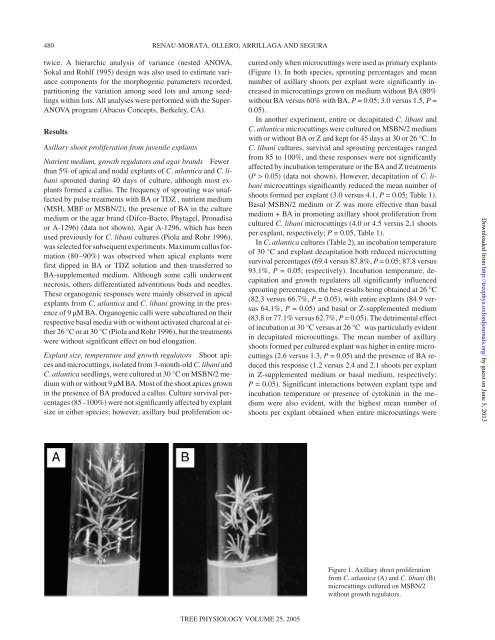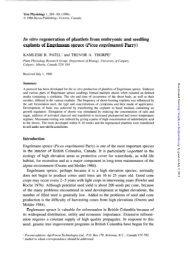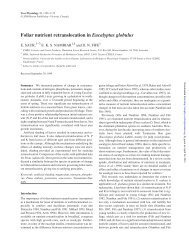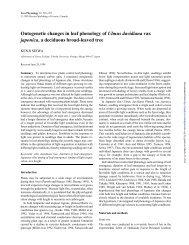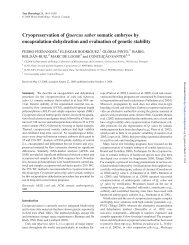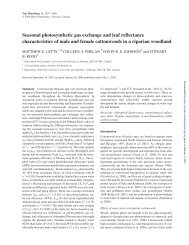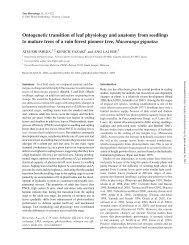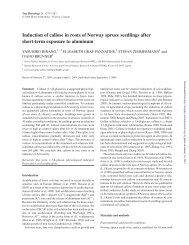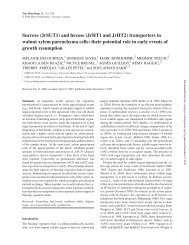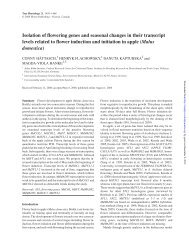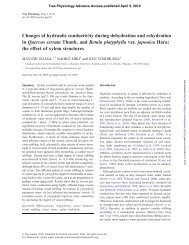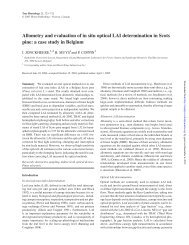Factors influencing axillary shoot proliferation and ... - Tree Physiology
Factors influencing axillary shoot proliferation and ... - Tree Physiology
Factors influencing axillary shoot proliferation and ... - Tree Physiology
You also want an ePaper? Increase the reach of your titles
YUMPU automatically turns print PDFs into web optimized ePapers that Google loves.
480 RENAU-MORATA, OLLERO, ARRILLAGA AND SEGURA<br />
twice. A hierarchic analysis of variance (nested ANOVA,<br />
Sokal <strong>and</strong> Rohlf 1995) design was also used to estimate variance<br />
components for the morphogenic parameters recorded,<br />
partitioning the variation among seed lots <strong>and</strong> among seedlings<br />
within lots. All analyses were performed with the Super-<br />
ANOVA program (Abacus Concepts, Berkeley, CA).<br />
Results<br />
Axillary <strong>shoot</strong> <strong>proliferation</strong> from juvenile explants<br />
Nutrient medium, growth regulators <strong>and</strong> agar br<strong>and</strong>s Fewer<br />
than 5% of apical <strong>and</strong> nodal explants of C. atlantica <strong>and</strong> C. libani<br />
sprouted during 40 days of culture, although most explants<br />
formed a callus. The frequency of sprouting was unaffected<br />
by pulse treatments with BA or TDZ , nutrient medium<br />
(MSH, MBF or MSBN/2), the presence of BA in the culture<br />
medium or the agar br<strong>and</strong> (Difco-Bacto, Phytagel, Pronadisa<br />
or A-1296) (data not shown). Agar A-1296, which has been<br />
used previously for C. libani cultures (Piola <strong>and</strong> Rohr 1996),<br />
was selected for subsequent experiments. Maximum callus formation<br />
(80–90%) was observed when apical explants were<br />
first dipped in BA or TDZ solution <strong>and</strong> then transferred to<br />
BA-supplemented medium. Although some calli underwent<br />
necrosis, others differentiated adventitious buds <strong>and</strong> needles.<br />
These organogenic responses were mainly observed in apical<br />
explants from C. atlantica <strong>and</strong> C. libani growing in the presence<br />
of 9 µM BA. Organogenic calli were subcultured on their<br />
respective basal media with or without activated charcoal at either<br />
26 °C or at 30 °C (Piola <strong>and</strong> Rohr 1996), but the treatments<br />
were without significant effect on bud elongation.<br />
Explant size, temperature <strong>and</strong> growth regulators Shoot apices<br />
<strong>and</strong> microcuttings, isolated from 3-month-old C. libani <strong>and</strong><br />
C. atlantica seedlings, were cultured at 30 °C on MSBN/2 medium<br />
with or without 9 µM BA. Most of the <strong>shoot</strong> apices grown<br />
in the presence of BA produced a callus. Culture survival percentages<br />
(85–100%) were not significantly affected by explant<br />
size in either species; however, <strong>axillary</strong> bud <strong>proliferation</strong> oc-<br />
TREE PHYSIOLOGY VOLUME 25, 2005<br />
curred only when microcuttings were used as primary explants<br />
(Figure 1). In both species, sprouting percentages <strong>and</strong> mean<br />
number of <strong>axillary</strong> <strong>shoot</strong>s per explant were significantly increased<br />
in microcuttings grown on medium without BA (80%<br />
without BA versus 60% with BA, P = 0.05; 3.0 versus 1.5, P =<br />
0.05).<br />
In another experiment, entire or decapitated C. libani <strong>and</strong><br />
C. atlantica microcuttings were cultured on MSBN/2 medium<br />
with or without BA or Z <strong>and</strong> kept for 45 days at 30 or 26 °C. In<br />
C. libani cultures, survival <strong>and</strong> sprouting percentages ranged<br />
from 85 to 100%, <strong>and</strong> these responses were not significantly<br />
affected by incubation temperature or the BA <strong>and</strong> Z treatments<br />
(P > 0.05) (data not shown). However, decapitation of C. libani<br />
microcuttings significantly reduced the mean number of<br />
<strong>shoot</strong>s formed per explant (3.0 versus 4.1, P = 0.05; Table 1).<br />
Basal MSBN/2 medium or Z was more effective than basal<br />
medium + BA in promoting <strong>axillary</strong> <strong>shoot</strong> <strong>proliferation</strong> from<br />
cultured C. libani microcuttings (4.0 or 4.5 versus 2.1 <strong>shoot</strong>s<br />
per explant, respectively; P = 0.05, Table 1).<br />
In C. atlantica cultures (Table 2), an incubation temperature<br />
of 30 °C <strong>and</strong> explant decapitation both reduced microcutting<br />
survival percentages (69.4 versus 87.8%, P = 0.05; 87.8 versus<br />
93.1%, P = 0.05; respectively). Incubation temperature, decapitation<br />
<strong>and</strong> growth regulators all significantly influenced<br />
sprouting percentages, the best results being obtained at 26 °C<br />
(82.3 versus 66.7%, P = 0.05), with entire explants (84.9 versus<br />
64.1%, P = 0.05) <strong>and</strong> basal or Z-supplemented medium<br />
(83.8 or 77.1% versus 62.7%, P = 0.05). The detrimental effect<br />
of incubation at 30 °C versus at 26 °C was particularly evident<br />
in decapitated microcuttings. The mean number of <strong>axillary</strong><br />
<strong>shoot</strong>s formed per cultured explant was higher in entire microcuttings<br />
(2.6 versus 1.3, P = 0.05) <strong>and</strong> the presence of BA reduced<br />
this response (1.2 versus 2.4 <strong>and</strong> 2.1 <strong>shoot</strong>s per explant<br />
in Z-supplemented medium or basal medium, respectively;<br />
P = 0.05). Significant interactions between explant type <strong>and</strong><br />
incubation temperature or presence of cytokinin in the medium<br />
were also evident, with the highest mean number of<br />
<strong>shoot</strong>s per explant obtained when entire microcuttings were<br />
Figure 1. Axillary <strong>shoot</strong> <strong>proliferation</strong><br />
from C. atlantica (A) <strong>and</strong> C. libani (B)<br />
microcuttings cultured on MSBN/2<br />
without growth regulators.<br />
Downloaded from<br />
http://treephys.oxfordjournals.org/ by guest on June 5, 2013


